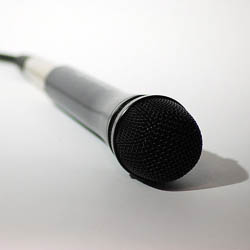
AMBIENCE
• Tape one or two boundary mics (such as PZM’s) or mini mics on a distant wall or on the control-room window. Do not cover the front of the mini mic with tape—it will muffle the sound.
AUDIENCE
• Place two cardioid condenser mics on either side of the stage, on mic stands, aiming at the back row of the audience.
• Hang the mics high over the front row of the audience.
• Tape two mini mics onto the ceiling over the audience about 3 feet apart, or tape a mini mic on the left wall and right wall.
GRAND PIANO
• Raise the lid. Tape a mini mic or boundary mic to the underside of the lid in the middle. For stereo, use two mics: one over the bass strings and one over the treble strings. If you need more isolation, close the lid and tweak EQ to remove the tubby coloration (usually you need to cut around 250 Hz). You might boost at 10 kHz for clarity.
• Raise or remove the lid. Place a flat condenser mic 8 inches over the treble strings, about 8 inches horizontally from the hammers. Place another flat condenser mic 8 inches over the bass strings, about 2 feet horizontally from the hammers. Aim both mics straight down. You might boost a few dB at 10 kHz for clarity.
• Use a stereo mic, or coincident pair of mics, 8 to 12 inches over the middle of the piano, about 8 inches horizontally from the hammers.
• For a classical-music solo, place a stereo mic or a stereo pair of mics about 7 to 9 feet away and 7 to 9 feet high. If you need to hear more room reverb, mix in a distant mic pair in the audience area, or add high-quality digital reverb.
UPRIGHT PIANO
• Remove the panel in front of the player to expose the strings. Place two mics (usually flat condensers) about 1 foot from the bass and treble strings.
• Face the soundboard toward the room (not next to a wall). Mike the soundboard a few inches from the bass and treble strings with two mics (ideally, flat condenser mics, but dynamic mics with a presence peak often work well).
• Face the soundboard toward the room (not next to a wall). Mike the soundboard next to the bass and treble strings with two mini mics.
XYLOPHONE OR MARIMBA
• Place two flat condensers or two mini mics 18 inches above the instrument and 2 feet apart.
BANJO
• For isolation, tape a mini mic to the drum head about 2 inches in from the rim. Also try one over a resonator hole. To get maximum isolation and gain-before-feedback, tape a mini mic inside onto the dowel rod, and turn down the excess bass in your mixer’s EQ.
• To get the most natural sound with a mini mic, use a mic clip to position the mic about 1 to 2 inches from the drum head, midway between the bridge and rim.
• Place a flat condenser or dynamic mic 6 to 12 inches from the drum head.
VIOLIN
• Place a flat condenser or ribbon mic 2 feet over the top. If the music is bluegrass, country, or old-time, place the mic 1 foot over the top. Aim toward the f-holes for a warm sound, or toward the neck for a thinner sound.
• For a fiddle player who sings, try a flat condenser or ribbon mic 1 foot over the fiddle, aiming at the player’s chin.
• For a bright sound, mount a mini mic between the bridge and tailpiece, under the strings. For a warmer sound, mount a mini mic near an f-hole.
• For a classical-music violin solo, place a stereo mic or stereo pair of mics about 12 to 20 feet away.
